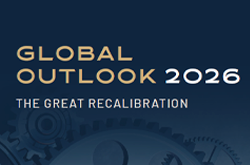Foggy Bottom*
In the midst of the rather dense fog created by the staggering uncertainty regarding potential health and economic outcomes, we take stock of the recent crop of data from China and the US.
A foggy bottom might have been reached in the first quarter of this year as far as China is concerned, and in the second quarter for most mature western economies, and this was to be expected given the respective confinement measures taken. Much uncertainty remains, however, as to the relative strength of manufacturing versus services, and the pace of the recovery.
Earlier Chinese data suggested a rather rapid rebound in manufacturing activity, leading to a general perception that the service sector would take longer to recover. However, China’s services PMI rose to 55 in May, from a low of 26.5 in February while the manufacturing PMI staged a more timid rise from 40.3 in February to 50.7 in May. To be sure, the larger gain in the services version of this indicator is partly a reflection of the severity of the prior decline, but it remains a fact that this sector now looks more buoyant than manufacturing. Moreover, we note that China’s industrial production rose by less in May than market expectations (4.4% year-on-year (YoY) and 5.0% on the same basis respectively) and retail sales fell by more (-2.8% YoY and -2.3% YoY respectively). China’s trade data for the month of May showed a smaller drop in exports than commonly thought (-3.3% YoY versus -6.5% according to the consensus). Imports, however, fell by as much as 16.7% YoY compared to market expectations of a 7.9% YoY decline. Part of this latter marked decline is of course due to the drop in the oil price. Taken together, the data points to more of a hockey-stick shaped recovery than the V-shape many had hoped for.
In the US, on the other hand, it is rather the contrary that has been revealed in the latest data releases as retail sales spectacularly exceeded expectations in May, rising by 17.7% on the month, against an anticipated gain of 8.4%. Durable goods orders for the month of April also widely exceeded expectations, falling by 5.8% from March rather than the -10.0% anticipated (non-defence excluding aircraft and parts). Shipments of said capital goods did even better relative to expectations, declining by 5.4% on the month versus a drop of 12.2% as per the consensus forecast. Moreover, personal income staged a surprising recovery in April, rising by 10.5% month-on-month (MoM) whereas a decline of 5.9% was deemed likely. As for the PMIs, Markit’s manufacturing version stands at 39.8 in May which is thus higher than the services PMI at 37.5 although the ISM’s equivalent measures record 43.1 for manufacturing and 45.4 for the service sector. The divergence might be explained by the ISM’s slant in favour of larger firms. US exports fell by 20.5% MoM in April – the largest decrease on record and this holds true also for imports which declined by nearly 14%. The April services trade surplus was the lowest since December 2016 on the back of the stalled travel and transport sectors, and the petroleum surplus was the highest on record. Interestingly, both exports to and imports from China increased but the latter by more, widening the bilateral trade deficit.
Overall, in China, services have surprised on the upside while in the US it is instead the manufacturing data that has come in stronger than expected. In addition, the size of the surprise has been greater in the US than in China, suggesting something more V-shaped in the former compared to the latter. This observation is captured in the CITI economic surprise index as can be seen in the chart below.
The conclusion is thus that there is room for positive surprises in the upcoming US GDP data. The third and final estimate pertaining to the first quarter of this year will be published on 25 June. In the second estimate, GDP contracted by 5% quarter-on-quarter (QoQ) annualised (QoQ multiplied by 4). The second quarter’s GDP is most certainly going to be much worse, but it is possible that our greatest fears might not be realised, although we will have to wait until 30 July before the release of the first estimate. Consensus expectations are for a QoQ annualised decline of 35% in the second quarter, the median of forecasts that range between -7.5% and -67% (-1.9% and -16.8% QoQ respectively) on the same basis in an eye-watering display of the uncertain times in which we live.
* Foggy Bottom is a Washington, DC neighbourhood along the Potomac River and which takes its name from the fog that naturally lingers there.
June 18, 2020




